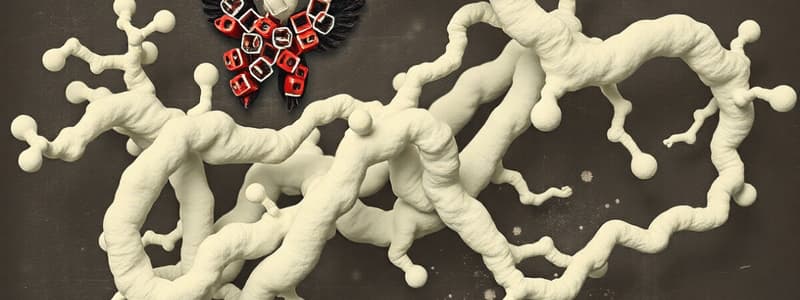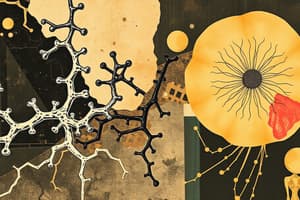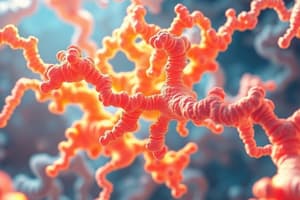Podcast
Questions and Answers
Which of the following statements about fibrous proteins is true?
Which of the following statements about fibrous proteins is true?
- They can be digested easily.
- They are soluble in water.
- They are not thermostable.
- They possess mechanical strength. (correct)
Collagen constitutes about 30% of total protein in the human body.
Collagen constitutes about 30% of total protein in the human body.
True (A)
What are the main types of muscle proteins mentioned?
What are the main types of muscle proteins mentioned?
Tropomyosin and Myosin
The hardness of keratin increases with the amount of ______ present in its structure.
The hardness of keratin increases with the amount of ______ present in its structure.
Match the types of keratin with their sources:
Match the types of keratin with their sources:
What property of collagen is primarily responsible for the pulling power in tendons and ligaments?
What property of collagen is primarily responsible for the pulling power in tendons and ligaments?
Elastin contains significant amounts of hydroxylysine.
Elastin contains significant amounts of hydroxylysine.
What vitamin deficiency can lead to a failure in the formation of Tropocollagen?
What vitamin deficiency can lead to a failure in the formation of Tropocollagen?
____ is a symptom associated with Ehlers-Danlos syndromes.
____ is a symptom associated with Ehlers-Danlos syndromes.
Match the disease with its associated collagen defect:
Match the disease with its associated collagen defect:
What is the primary function of myoglobin?
What is the primary function of myoglobin?
Human Serum Albumin constitutes nearly 50% of all plasma proteins.
Human Serum Albumin constitutes nearly 50% of all plasma proteins.
What is the significance of the heme group in hemoglobin?
What is the significance of the heme group in hemoglobin?
Globulins are generally _____ than albumins and less soluble in water.
Globulins are generally _____ than albumins and less soluble in water.
Match the protein type to its characteristic:
Match the protein type to its characteristic:
Which type of hemoglobin is primarily associated with adults?
Which type of hemoglobin is primarily associated with adults?
Deoxyhemoglobin can bind to carbon dioxide and hydrogen.
Deoxyhemoglobin can bind to carbon dioxide and hydrogen.
What are the two states of hemoglobin and their affinities for oxygen?
What are the two states of hemoglobin and their affinities for oxygen?
HbF is made up of ______ and ______ subunits.
HbF is made up of ______ and ______ subunits.
Match the types of hemoglobin with their description:
Match the types of hemoglobin with their description:
Which of the following cross-links are found in elastin?
Which of the following cross-links are found in elastin?
Elastin is formed from multiple genetic types.
Elastin is formed from multiple genetic types.
What structural feature differentiates collagen from elastin regarding their helices?
What structural feature differentiates collagen from elastin regarding their helices?
In silk fibroin, nearly half of the amino acids are __________.
In silk fibroin, nearly half of the amino acids are __________.
Match the following features with the correct protein: Collagen, Elastin, Silk Fibroin.
Match the following features with the correct protein: Collagen, Elastin, Silk Fibroin.
Which property is NOT associated with globular proteins?
Which property is NOT associated with globular proteins?
Hydroxylysine is present in elastin.
Hydroxylysine is present in elastin.
Name two types of cross-links found in elastin.
Name two types of cross-links found in elastin.
Silk fibroin has a ___________ sheet structure.
Silk fibroin has a ___________ sheet structure.
Which modification is NOT present in elastin?
Which modification is NOT present in elastin?
What is the Bohr effect primarily associated with?
What is the Bohr effect primarily associated with?
The binding of 2,3-BPG to hemoglobin increases its affinity for oxygen.
The binding of 2,3-BPG to hemoglobin increases its affinity for oxygen.
What is the primary role of carbonic anhydrase in the blood?
What is the primary role of carbonic anhydrase in the blood?
The shift of the HbO2 dissociation curve to the right occurs in ______ pH conditions.
The shift of the HbO2 dissociation curve to the right occurs in ______ pH conditions.
Match the following terms with their definitions:
Match the following terms with their definitions:
Why is 2,3-BPG important for transfused blood?
Why is 2,3-BPG important for transfused blood?
Carbon monoxide is a beneficial gas released during respiration.
Carbon monoxide is a beneficial gas released during respiration.
What happens to oxygen release when blood is transfused without 2,3-BPG?
What happens to oxygen release when blood is transfused without 2,3-BPG?
Flashcards
Fibrous Proteins
Fibrous Proteins
Insoluble in water, not easily digested, and resistant to heat. They give mechanical strength to tissues.
Keratin
Keratin
A fibrous protein found in hair, nails, and skin. Its strength depends on cysteine content; higher cysteine means harder.
Collagen
Collagen
A fibrous protein, a major component of connective tissues like skin and tendons. High content in body (30% total protein).
Cysteine in Keratin
Cysteine in Keratin
Signup and view all the flashcards
Protein Classification (Composition)
Protein Classification (Composition)
Signup and view all the flashcards
Collagen Properties
Collagen Properties
Signup and view all the flashcards
Collagen Cross-linking
Collagen Cross-linking
Signup and view all the flashcards
Collagen Deficiency (Scorbutus)
Collagen Deficiency (Scorbutus)
Signup and view all the flashcards
Ehlers-Danlos Syndrome
Ehlers-Danlos Syndrome
Signup and view all the flashcards
Elastin Function
Elastin Function
Signup and view all the flashcards
Cross-links in Elastin
Cross-links in Elastin
Signup and view all the flashcards
Desmosine
Desmosine
Signup and view all the flashcards
Collagen vs. Elastin
Collagen vs. Elastin
Signup and view all the flashcards
Collagen Structure
Collagen Structure
Signup and view all the flashcards
Elastin Structure
Elastin Structure
Signup and view all the flashcards
Silk Fibroin
Silk Fibroin
Signup and view all the flashcards
Globular Proteins
Globular Proteins
Signup and view all the flashcards
β-pleated sheet
β-pleated sheet
Signup and view all the flashcards
Glycine in Silk Fibroin
Glycine in Silk Fibroin
Signup and view all the flashcards
Protein Conjugation
Protein Conjugation
Signup and view all the flashcards
Hemoglobin's Structure
Hemoglobin's Structure
Signup and view all the flashcards
Myoglobin Function
Myoglobin Function
Signup and view all the flashcards
Heme Group Function
Heme Group Function
Signup and view all the flashcards
Hemoglobin Heme Pocket
Hemoglobin Heme Pocket
Signup and view all the flashcards
Human Serum Albumin Function
Human Serum Albumin Function
Signup and view all the flashcards
Hb Gower 1
Hb Gower 1
Signup and view all the flashcards
HbF
HbF
Signup and view all the flashcards
HbA
HbA
Signup and view all the flashcards
HbA2
HbA2
Signup and view all the flashcards
What factors influence Hb glycosylation?
What factors influence Hb glycosylation?
Signup and view all the flashcards
What is the Bohr effect?
What is the Bohr effect?
Signup and view all the flashcards
How does carbon dioxide affect hemoglobin-oxygen binding?
How does carbon dioxide affect hemoglobin-oxygen binding?
Signup and view all the flashcards
What is Cl- shift?
What is Cl- shift?
Signup and view all the flashcards
What is 2,3-BPG?
What is 2,3-BPG?
Signup and view all the flashcards
Why is 2,3-BPG important in transfused blood?
Why is 2,3-BPG important in transfused blood?
Signup and view all the flashcards
What happens to the HbO2 dissociation curve at lower pH?
What happens to the HbO2 dissociation curve at lower pH?
Signup and view all the flashcards
How does carbon monoxide affect oxygen carrying capacity?
How does carbon monoxide affect oxygen carrying capacity?
Signup and view all the flashcards
What is the relationship between oxygen affinity and carbon dioxide levels?
What is the relationship between oxygen affinity and carbon dioxide levels?
Signup and view all the flashcards
Study Notes
Protein Classification and Function
- Proteins are classified based on shape (structural) and composition.
- Structural proteins have various shapes, including fibrous and globular.
- Fibrous proteins are typically insoluble in water, strong, and provide structural support. Examples include keratin, collagen, and elastin.
- Globular proteins have a complex, roughly spherical shape, and are usually soluble in water. They have diverse functions. Examples include hormones, enzymes, antibodies, and transport proteins (like hemoglobin and myoglobin).
- Protein composition can be simple or conjugated. Simple proteins consist only of amino acids. Conjugated proteins contain additional components such as metals, lipids, or carbohydrates.
Learning Objectives
- Students will be able to classify proteins.
- Students will understand the structural properties of fibrous proteins.
- Students will compare and contrast the structures of keratin, collagen, and elastin.
- Students will know the definition and structural properties of globular proteins.
- Students will understand the structures and functions of myoglobin and its oxygen-binding properties.
- Students will understand the structures and functions of hemoglobin and its oxygen-binding properties.
Classification of Proteins
- Structural (Shape): Determined by amino acid sequence. Fibrous proteins are elongated and provide strength (e.g., keratin in hair). Globular proteins are compact and often have diverse functions.
- Composition: Simple proteins consist only of amino acids. Conjugated proteins contain other molecules (e.g., heme in hemoglobin).
Fibrous Proteins
- Scleroproteins: Insoluble in water, resistant to digestion, provide strength and structure. Examples include keratin (hair, nails), collagen (connective tissue), elastin (elastic fibers).
Collagen
- Accounts for ~30% of total body protein and is essential for connective tissues.
- Has various types, with different structures and functions.
- Physical properties (e.g., elasticity, strength) differ depending on the tissue location.
- Crucial for skin, bones, tendons, and ligaments.
- Essential for wound healing.
Elastin
- Provides elasticity and flexibility in tissues such as skin, blood vessels, and lungs.
- Predominantly hydrophobic.
- Rich in glycine, alanine, and lysine; contains small amounts of hydroxyproline but no hydroxylysine.
Silk Fibroin
- A fibrous protein found in silk.
- A β-sheet structure composed of repeating amino acid sequences (mostly glycine and alanine).
- Provides strength and flexibility to the silk fiber.
Globular Proteins
- Mostly conjugated, meaning they have additional components besides amino acids.
- Examples include albumins and globulins.
- Diverse functions including catalysis, transport, storage, gene regulation, immunity, etc.
- They are usually soluble in water
Albumins
- Part of the larger protein family.
- Abundant in blood, approximately 50% of plasma proteins.
- Involved in transporting hormones, fatty acids.
- Important for maintaining osmotic pressure (keeping blood in the blood vessels).
Globulins
- Larger than albumins.
- Less soluble in water.
- Important in various bodily functions, including blood clotting, immune responses, and transporting various molecules.
Hemoglobin and Myoglobin
- Function: Carry or store oxygen.
- Structure: Contain heme groups. These groups have iron, which binds to oxygen.
- Myoglobin: Single polypeptide chain, stores oxygen in muscle tissue.
- Hemoglobin: Four polypeptide chains, transports oxygen in the blood.
2,3-BPG and Hemoglobin
- 2,3-BPG is a molecule that binds to hemoglobin, reducing its affinity for oxygen, and aids the release of oxygen in tissues.
Carbon Monoxide and Hemoglobin
- Carbon monoxide binds tightly to heme, preventing oxygen binding.
- It displaces the oxygen, effectively blocking oxygen transport.
Bohr Effect
- The effect of pH on hemoglobin's oxygen binding capacity.
- As pH decreases, hemoglobin's affinity for oxygen decreases, facilitating oxygen release in tissues.
Studying That Suits You
Use AI to generate personalized quizzes and flashcards to suit your learning preferences.




